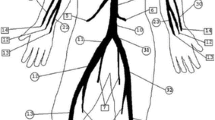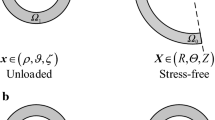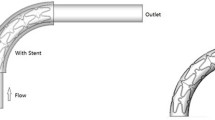Abstract
Acute stress concentration plays an important role in plaque rupture and may cause stroke or myocardial infarction. Quantitative evaluation of the relation between in vivo plaque stress and variations in blood pressure and flow rates is valuable to optimize daily monitoring of the cardiovascular system for high-risk patients as well as to set a safe physical exercise intensity for better quality of life. In this study, we constructed an in vivo stress model for a human carotid bifurcation with atherosclerotic plaque, and analyzed the effects of blood pressure, flow rates, plaque stiffness, and stenosis on the elastic stress and fluid viscous stress around the plaque. According to the maximum values of the mechanical stress, we define a risk index to predict the risk level of plaque rupture under different exercise intensities. For a carotid bifurcation where the blood flow divides, the results suggest that the stenosis ratio determines the ratio of the contributions of elastic shear stress and viscous shear stress to plaque rupture. An increase of the plaque stiffness enhances the maximum elastic shear stress in the plaque, indicating that a high-stiffness plaque is more prone to rupture for given stenosis ratio. High stress co-localization at the shoulder of plaques agrees with the region of plaque injury in clinical observations. It is demonstrated that, due to the stress-shield effect, the rupture risk of a high-stiffness plaque tends to decrease under high-stenosis conditions, suggesting the existence of a specific stenosis corresponding to the maximum risk. This study may help to complement risk stratification of vulnerable plaques in clinical practice and provides a stenosis mechanical property-specific guide for blood pressure control in cardiovascular health management.








Similar content being viewed by others
References
Benjamin, E.J., Blaha, M.J., Chiuve, S.E., et al.: Heart disease and stroke statistics-2017 update. Circulation 135, e146–e603 (2017)
Green, D.J., Hopman, M.T.E., Padilla, J., et al.: Vascular adaptation to exercise in humans: role of hemodynamic stimuli. Physiol. Rev. 97, 495–528 (2017)
Palmefors, H., DuttaRoy, S., Rundqvist, B., et al.: The effect of physical activity or exercise on key biomarkers in atherosclerosis—a systematic review. Atherosclerosis 235, 150–161 (2014)
Goto, C., Nishioka, K., Umemura, T., et al.: Acute moderate-intensity exercise induces vasodilation through an increase in nitric oxide bioavailiability in humans. Am. J. Hypertens. 20, 825–830 (2007)
Burke, A.P., Farb, A., Malcom, G.T., et al.: Plaque rupture and sudden death related to exertion in men with coronary artery disease. J. Am. Med. Assoc. 281, 921–926 (1999)
Brown, A.J., Teng, Z., Evans, P.C., et al.: Role of biomechanical forces in the natural history of coronary atherosclerosis. Nat. Rev. Cardiol. 13, 210–220 (2016)
Chiu, J.J., Chien, S.: Effects of disturbed flow on vascular endothelium: pathophysiological basis and clinical perspectives. Physiol. Rev. 91, 327–387 (2011)
Harrison, D.G., Widder, J., Grumbach, I., et al.: Endothelial mechanotransduction, nitric oxide and vascular inflammation. J. Intern. Med. 259, 351–363 (2006)
Wentzel, J.J., Chatzizisis, Y.S., Gijsen, F.J.H., et al.: Endothelial shear stress in the evolution of coronary atherosclerotic plaque and vascular remodelling: current understanding and remaining questions. Cardiovasc. Res. 96, 234–243 (2012)
Dolan, J.M., Kolega, J., Meng, H.: High wall shear stress and spatial gradients in vascular pathology: a review. Ann. Biomed. Eng. 41, 1411–1427 (2013)
Sameshima, N., Yamashita, A., Sato, S., et al.: The values of wall shear stress, turbulence kinetic energy and blood pressure gradient are associated with atherosclerotic plaque erosion in rabbits. J. Atheroscler. Thromb. 21, 831–838 (2014)
Rodríguez, A.I., Csányi, G., Ranayhossaini, D.J., et al.: MEF2B-Nox1 signaling is critical for stretch-induced phenotypic modulation of vascular smooth muscle cells. Arterioscler. Thromb. Vasc. Biol. 35, 430–438 (2015)
Jufri, N.F., Mohamedali, A., Avolio, A., et al.: Mechanical stretch: physiological and pathological implications for human vascular endothelial cells. Vasc. Cell. 7, 8 (2015)
Holzapfel, G.A., Mulvihill, J.J., Cunnane, E.M., et al.: Computational approaches for analyzing the mechanics of atherosclerotic plaques: a review. J. Biomech. 47, 859–869 (2014)
Huang, Y., Teng, Z., Sadat, U., et al.: The influence of computational strategy on prediction of mechanical stress in carotid atherosclerotic plaques: comparison of 2D structure-only, 3D structure-only, one-way and fully coupled fluid-structure interaction analyses. J. Biomech. 47, 1465–1471 (2014)
Tang, D., Yang, C., Kobayashi, S., et al.: Effect of stenosis asymmetry on blood flow and artery compression: a three-dimensional fluid-structure interaction model. Ann. Biomed. Eng. 31, 1182–1193 (2003)
Cilla, M., Peña, E., Martínez, M.A.: 3D computational parametric analysis of eccentric atheroma plaque: influence of axial and circumferential residual stresses. Biomech. Model. Mechanobiol. 11, 1001–1013 (2012)
Yang, S., Zhang, L.T., Hua, C., et al.: A prediction of in vivo mechanical stresses in blood vessels using thermal expansion method and its application to hypertension and vascular stenosis. Acta Mech. Sin. 34, 1156–1166 (2018)
Slager, C., Wentzel, J., Gijsen, F., et al.: The role of shear stress in the generation of rupture-prone vulnerable plaques. Nat. Clin. Pract. Cardiovasc. Med. 2, 401–407 (2005)
Delfino, A., Stergiopulos, N., Moore, J.E., et al.: Residual strain effects on the stress field in a thick wall finite element model of the human carotid bifurcation. J. Biomech. 30, 777–786 (1997)
Holzapfel, G.A., Gasser, T.C., Ogden, R.W.: A new constitutive framework for arterial wall mechanics and a comparative study of material models. J. Elast. 61, 1–48 (2000)
Barrett, S.R.H., Sutcliffe, M.P.F., Howarth, S., et al.: Experimental measurement of the mechanical properties of carotid atherothrombotic plaque fibrous cap. J. Biomech. 42, 1650–1655 (2009)
Bluestein, D., Alemu, Y., Avrahami, I., et al.: Influence of microcalcifications on vulnerable plaque mechanics using FSI modeling. J. Biomech. 41, 1111–1118 (2008)
Hellstrom, G., Fischer-Colbrie, W., Wahlgren, N.G., et al.: Carotid artery blood flow and middle cerebral artery blood flow velocity during physical exercise. J. Appl. Physiol. 81, 413–418 (1996)
Timmins, L.H., Molony, D.S., Eshtehardi, P., et al.: Focal association between wall shear stress and clinical coronary artery disease progression. Ann. Biomed. Eng. 43, 94–106 (2014)
Li, Z.Y., Howarth, S., Trivedi, R.A., et al.: Stress analysis of carotid plaque rupture based on in vivo high resolution MRI. J. Biomech. 39, 2611–2622 (2006)
Morbiducci, U., Kok, A.M., Kwak, B.R., et al.: Atherosclerosis at arterial bifurcations: evidence for the role of haemodynamics and geometry. Thromb. Haemost. 115, 484–492 (2016)
Peckham, M.E., Kim, S., Parker, D.L., et al.: Abstract TP241: correlation of MRI cerebral perfusion parameters and carotid plaque characteristics. Stroke 50, ATP241 (2019)
Barrett, H.E., Cunnane, E.M., Kavanagh, E.G., et al.: On the effect of calcification volume and configuration on the mechanical behaviour of carotid plaque tissue. J. Mech. Behav. Biomed. Mater. 56, 45–56 (2016)
Cunnane, E.M., Mulvihill, J.J.E., Barrett, H.E., et al.: Mechanical properties and composition of carotid and femoral atherosclerotic plaques: a comparative study. J. Biomech. 49, 3697–3704 (2016)
Teng, Z., Yuan, J., Feng, J., et al.: The influence of constitutive law choice used to characterise atherosclerotic tissue material properties on computing stress values in human carotid plaques. J. Biomech. 48, 3912–3921 (2015)
Acknowledgements
This work was supported by the National Key R&D Program of China (Grant 2017YFE0117100), the National Natural Science Foundation of China (Grants 11872040 and 11232010), the Outstanding Clinical Discipline Project of Shanghai Pudong (Grant PWYgy-2018-08), and the Science and Technology Commission of Shanghai Municipality (Grant 18ZR1433900).
Author information
Authors and Affiliations
Corresponding author
Rights and permissions
About this article
Cite this article
Yang, S., Wang, Q., Shi, W. et al. Numerical study of biomechanical characteristics of plaque rupture at stenosed carotid bifurcation: a stenosis mechanical property-specific guide for blood pressure control in daily activities. Acta Mech. Sin. 35, 1279–1289 (2019). https://doi.org/10.1007/s10409-019-00883-w
Received:
Revised:
Accepted:
Published:
Issue Date:
DOI: https://doi.org/10.1007/s10409-019-00883-w




